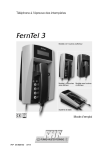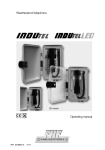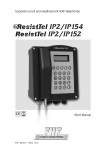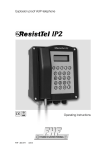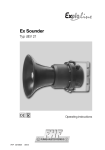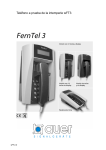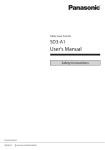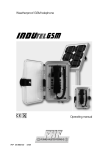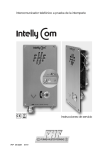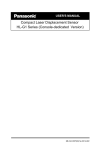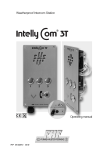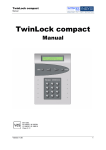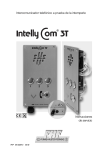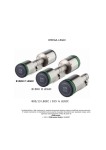Download User Manual
Transcript
Industrial Weatherproof Telephone FernTel 3000 UL Registration Number E209659 FCC Registration Number 6SH Ger-35065-TF-E Ringer Equivalence Number REN 0,9B User manual FHF BA 9600-1 12/03 Telephone Characters LC Display The telephone is in programming mode. Dialling procedure PD (Pulse Dialling) is ON The number from the last number redial memory is being dialled. Inquiry call mode is ON Dialling procedure DTMF (Dual-tone multifrequency) is ON The Amplified Listening in Receiver feature is ON Keyboard ➝ Amplified Listening in Receiver feature ➝ Programming key ➝ Last number redial ➝ Inquiry key ➝ Hash sign (only in DTMF mode) ➝ Asterisk (only in DTMF mode) Note Please read the User Manual carefully prior to installing the telephone. Make sure no equipment parts are missing. Table of contents Mounting options Display and keyboard Important Safety Instructions . . . . . . . . . . . . . . . . . . . . . . . . . . . . . . . . . . . . . . . 4 Safety and warning notes . . . . . . . . . . . . . . . . . . . . . . . . . . . . . . . . . . . . . . . . . . 4 Package contents . . . . . . . . . . . . . . . . . . . . . . . . . . . . . . . . . . . . . . . . . . . . . . . . 5 General operating instructions . . . . . . . . . . . . . . . . . . . . . . . . . . . . . . . . . . . . . 5 Setting up the telephone . . . . . . . . . . . . . . . . . . . . . . . . . . . . . . . . . . . . . . . . . . 6 Mounting the telephone on the wall . . . . . . . . . . . . . . . . . . . . . . . . . . . . . . . . . . . . 6 Setting up the telephone on the desktop . . . . . . . . . . . . . . . . . . . . . . . . . . . . . . . . 6 Connecting a secondary sounder . . . . . . . . . . . . . . . . . . . . . . . . . . . . . . . . . . . . . . 6 Exchange of a cable gland . . . . . . . . . . . . . . . . . . . . . . . . . . . . . . . . . . . . . . . . . . . 6 Operating procedures . . . . . . . . . . . . . . . . . . . . . . . . . . . . . . . . . . . . . . . . . . . . 7 Setting the ringing melody . . . . . . . . . . . . . . . . . . . . . . . . . . . . . . . . . . . . . . . . . . . 7 Setting the ringing volume . . . . . . . . . . . . . . . . . . . . . . . . . . . . . . . . . . . . . . . . . . . 7 Amplified Listening in Receiver feature . . . . . . . . . . . . . . . . . . . . . . . . . . . . . . . . . . 7 Last number redial . . . . . . . . . . . . . . . . . . . . . . . . . . . . . . . . . . . . . . . . . . . . . . . . . 7 Using the telephone with telephone systems . . . . . . . . . . . . . . . . . . . . . . . . . 7 Network access . . . . . . . . . . . . . . . . . . . . . . . . . . . . . . . . . . . . . . . . . . . . . . . . . . . 7 Programming the automatic pause for network access . . . . . . . . . . . . . . . . . . . . . 7 Disable / enable device programming . . . . . . . . . . . . . . . . . . . . . . . . . . . . . . . . . . 7 Entering and change a Personal Identification Number (PIN) . . . . . . . . . . . . . . . . . 7 Factory settings .................................................8 Setup procedure . . . . . . . . . . . . . . . . . . . . . . . . . . . . . . . . . . . . . . . . . . . . . . . . . 8 Signal tones . . . . . . . . . . . . . . . . . . . . . . . . . . . . . . . . . . . . . . . . . . . . . . . . . . . . . 8 General notes . . . . . . . . . . . . . . . . . . . . . . . . . . . . . . . . . . . . . . . . . . . . . . . . . . . 9 User Instructions . . . . . . . . . . . . . . . . . . . . . . . . . . . . . . . . . . . . . . . . . . . . . . . . . . 9 Service . . . . . . . . . . . . . . . . . . . . . . . . . . . . . . . . . . . . . . . . . . . . . . . . . . . . . . . . . . 9 Maintenance and cleaning . . . . . . . . . . . . . . . . . . . . . . . . . . . . . . . . . . . . . . . . . . . 9 Replacement parts . . . . . . . . . . . . . . . . . . . . . . . . . . . . . . . . . . . . . . . . . . . . . . . . . 9 Warranty . . . . . . . . . . . . . . . . . . . . . . . . . . . . . . . . . . . . . . . . . . . . . . . . . . . . . . . . 10 Technical data . . . . . . . . . . . . . . . . . . . . . . . . . . . . . . . . . . . . . . . . . . . . . . . . . . . 11 Illustrated operating procedures 3 Warning and security notes When installing any telephone equipment, please observe to the following guidelines to ensure the safety of all personnel: – NEVER install telephone wiring during a lightning storm. – NEVER install telephone jacks in wet locations unless the jack is specifically designed for wet locations. – NEVER touch uninsulated telephone wires or terminals unless the telephone line has been disconnected at the network interface. – USE CAUTION when installing or modifying telephone lines. – TO REDUCE the risk of fire use only No. 26 AWG or larger telecommunication line cord This device is a weatherproof telephone designed for use in a rough industry environment. The following warning and safety notes must be observed: 1. The telephone may be connected to and operated with the prescribed voltage only. Make sure the telephone is properly connected. The connecting wire must be routed in a way to prevent persons from tripping over it. 2. The telephone may be operated under the environmental conditions laid down in Technical Data only. Operation in hostile environmental conditions, for instance too high or too low ambient temperatures, is not allowed, as this may cause electronic parts to malfunction. 3. Make sure the telephone connecting wire and any other parts of the telephone are not damaged. lf the telephone has been damaged it should not be operated. 4. During operation of the telephone legal and professional regulations, safety regulations, and electrical regulations must be observed. 5. lf the telephone has to be repaired, the repair must be done professionally, using original spare parts only. Spare parts from other sources may cause damage. 6. Prior to maintenance or replacement of the telephone the line must be disconnected. Maintenance or repair works that have to be carried out while electrical power is connected may be carried out only by trained and skilled personnel. 7. The listening quality may be marginally reduced due to the influence of strong external magnetic fields. 8. The manufacturer of this product reserves the right to technical alterations without further notice. 9. Although this equipment can use either loop disconnect or DTMF signaling, only the performance of the DTMF signaling is subject to regulatory requirements for correct operation. It is strongly recommended that the equipment be set to use DTMF signaling for access to public or private emergency services. DTMF signaling also provides faster call set up. 4 Package contents The delivery consists of: – 1 industrial telephone, type WTS 100 – options bag with latching hook cover and 4 rubber stand-offs (for desktop version) – this user manual General operating instructions 1. The weatherproof telephone, type WTS 100, has been developed to access analogue dial-up ports. 2. The telephone is equipped with a proximity detecting hook switch. This means that the handset must be put down to interrupt or end an active call. 3. Memory procedures, which begin with the programming key with this key in order to be stored in memory. , must also end 4. The receiver must be lifted to enable programming of the different functions. 5. If more than 2 minutes pass without a number being dialed, the exchange may turn off the power supply. You will then no longer hear a dial tone. In this case put down the receiver and wait approximately 2 seconds before you lift it again. Procedures, which you have begun, but not yet completed using the programming key , must be repeated. 6. If a procedure has been successfully completed, you will hear an acknowledgement tone. An error tone informs you in case of an operating error. 7. If you are receiving a call, your telephone will ring with the ringing sound pressure level you have set. When the telephone is ringing the H E L L O is shown on the display. 8. The receiver has a receiver inset, which is equipped with a magnetic field sender. User of hearing aids with an inductive receiver may receive the signal of the receiver inset directly with this telephone. 9. Forgetting the PIN is comparable to losing a key. If you have forgotten your PIN, please contact one of our service dealers. 5 Setting up the telephone Mounting the telephone on the wall Open the telephone by loosing the 4 cover screws 12, and screw the base 1 onto the wall or another carrier using 3 screws (see front cover for details). Use three 1⁄4-20 machine screws 5 with nuts or #14 wood screws with dowel of appropriate length, depending on the mounting surface. The mounting surface should be even to rest on all three stand-offs. Connect the telephone according to the connection diagram (Fig. 2). Please note that the cable diameter must comply with the corresponding dimensions of the cable gland, otherwise the requirements of the NEMA / IP rating will not be fulfilled. When all the connections have been made, fasten lid 2 on base 1 with screws 12. The operating procedures may now be used to perform individual adjustments Fig. 2 of the telephone. Check for proper telephone operation by calling to and from another telephone. Setting up the telephone on desktop Open the telephone by loosening the 4 lid screws 12, turn lid 2 180° and screw it on to base 1. It is recommended to remove the latching hook 6 by unscrewing screw 7 and replace it by the enclosed cover. The ship-with, self adhesive rubber stand-offs 8 should be placed in the corresponding recesses in the base. Connect the telephone according to the diagram (Fig. 2). Check for proper telephone operation by calling to and from another telephone. Connecting a secondary sounder If you want the telephone to control a secondary sounder as well, you will have to replace the blind plug 10 by a cable gland NPT 1/2" with hexagon 24 mm, NEMA 4X / IP 66. Please note that the cable diameter must comply with the corresponding dimensions of the cable gland, otherwise the requirements of the NEMA / IP rating will not be fulfilled. The secondary sounder is connected at the terminals Second Ringer (Fig. 2). When all the connections have been made, fasten lid 2 on base 1 with screw 12. Exchange of a cable gland If you wish to replace the cable gland fitted in the factory with a different one – use only size 1/2", NEMA 4X – isolate the telephone from the telephone network. Unscrew the 4 lid screws 12 and open the telephone. Remove the cables from the relevant cable gland. Loosen the counter nut (spanner size 24) on the cable gland and remove it. Before fitting a new cable gland, check the seal of the housing for possible damage. Insert a new cable gland and fasten it with a suitable counter nut. Then pull your cables through the cable gland and connect each lead as shown in Fig. 2. Follow the instructions given by the manufacturer of the cable gland regarding type and size of the cable allowed. When all the connections have been made, fasten lid 2 on base 1 with screw 12. 6 Operating procedures Using the accompanying procedure and the keys 0 through 9 the ringing melody may be individually modified. In the factory settings the key 1 is the active setting. Using the accompanying procedure the ringing volume may be adjusted in stages from 1 to 5 (1 = low; 5 = high) and stored, even during an active call. In the as-delivered condition this function is set to stage 5. The telephone enables you to boost the normal volume in the handset by 6 dB or 12 dB. After having lifted the handset by used to adjust the set receiver volume. When the handset is hung up again, the receiver volume will return to normal. If you have dialed a telephone number and the other participant does not answer, or the line is busy, please try again by using the last number redial. You may program the Inquiry key function yourself, if you use dual-tone multifrequency (DTMF) Programmable Automatic Pause Function (APF). If a code is required to gain access to the next level of the network (internal or external) it is not necessary to pause between the access code (typically 0 or 9) and the required number. The APF once activated during set up will automatically inset the correct delay required by the system. The APF offers a choice of short or long pause to ensure compatibility with most switches. The factory setting is for a short pause. Please refer to your terminal equipment documentation to determine the delay required for your system. Certain settings, like for instance disable/enable device programming, are protected by a code number against random change or misuse. In the factory setting the PIN 0000 is the active setting. You may charge the PIN. • Forgetting the PIN is comparable to losing a key. If you have forgotten your PIN, please contact your FHF dealer. Please unfold back cover ! Setting the ringing options Setting the ringing sound pressure level Amplified Listening Receiver function Last number redial Programming the enquiry key – earth Programming the enquiry key – flash Entering the APF Programming the duration of the APF Deleting the APF Disable device programming Enable device programming Change PIN 7 Factory settings The factory settings are as follows: Dialing procedure DTMF (tone duration 90 ms) Amplified Listening in Receiver function two-stage (6 dB/12 dB) Signaling Flash 80 ms Sounder response frequency (15 … 68) Hz Automatic Pause Function 3s Melody 1 Ringing sound pressure level 5 PIN 0000 If the factory setting does not correspond to the technical data of the telephone system the setup procedure needs to be programmed accordingly. Setup procedure Setup performance features (CODE) Function Ringing response Sounder response frequency 23 … 68 Hz 15 … 54 Hz 23 … 54 Hz 15 … 68 Hz Dialing parameter DTMF, tone duration unlimited DTMF, tone duration 70 ms DTMF, tone duration 90 ms PD 1,5 : 1 PD 2 : 1 Deleting memory and restoring the factory settings Code 41 42 43 44 91 92 93 94 95 33 • When „Restoring the factory settings“ the existing PIN will not be changed automatically. Signal tones In addition to the ringing melody, which sounds upon every incoming call, your telephone may send out further acoustic signals in the form of simple tones, which may serve to give you useful information during programming. Tone Number Acknowledgement tone 1 long tone Error tone 8 Significance Completing a correctly performed procedure 4 short tones An error has been registered during the course of a procedure. Procedure cancelled. General notes User Instructions Federal Communication Commission regulations require that the following instructions be followed when connecting to the US public telephone network. This equipment complies with Part 68 of the FCC Rules. On the front panel of this equipment is a label that contains, among other information, the FCC Registration Number and Ringer Equivalence Number (REN) for this equipment. If requested, this information must be given to the telephone company. The REN is used to determine the quality of devices you may connect to your telephone line and still have all of those devices ring when your telephone number is called. In most, but not all areas, the sum of the REN of all devices connected to one line should not exceed five (5.0). To be certain of the number of devices you may connect to the line, as determined by the REN, you should contact your local telephone company to determine the maximum REN for your calling area. If your telephone equipment causes harm to the telephone network, the telephone company may discontinue your service temporarily ( see the note at the end of this section). If possible, they will notify and you will be informed of your right to file a complaint with the FCC. Your telephone company may make changes in their facilities, equipment, operations, or procedures that could affect the proper functioning of your equipment. If they do, you will be notified in advance to give you an opportunity to maintain uninterrupted telephone service. Note. The telephone company may ask that you disconnect this equipment from the network until the problem has been corrected or until you are sure that the equipment is not malfunctioning. This equipment may not be used on party lines or coin service provided by telephone company. Service You have purchased a modern FHF product, which has been subject to rigid quality control. lf you have any questions about this telephone, or if malfunctions should occur even after the guarantee period – please contact your FHF dealer. Before you make the call, however, please find the type and product numbers on the product name plate. Maintenance and cleaning The telephone is maintenance free. lf it is operated in areas where it is subjected to large amounts of dust, grease, oil etc. the telephone should be cleaned from time to time. Use a moist cloth to wipe off the device. Warning ! Never use sharp or pointed instruments to clean the telephone. Do not use cleaning agents. Replacement parts For a detailed list please contact your local agent or contact email: [email protected] 9 Warranty Equipment. FHF warrants for a period of one (1) year from the data of shipment, that any FHF equipment supplied hereunder shall be free of defects in material and workmanship, shall comply with the then-current product specifications and product literature, and if applicable, shall be fit for the purpose specified in the agreed upon quotation or proposal document. If (a) Seller’s goods prove to be defective in workmanship and/or material under normal and proper usage, or unfit for the purpose specified and agreed upon, and (b) Buyer’s claim is made within the warranty period set forth above, Buyer’s sole and exclusive remedy, and the warranty period on any repaired or replacement equipment shall be one (1) year from the date the original equipment was shipped. In no event shall FHF warranty obligations with respect to equipment exceed 100 % of the total cost of the equipment supplied hereunder. Buyer may also be entitled to the manufacturer’s warranty on any third-party goods supplied by FHF hereunder. The applicability of any such third-party warranty will be determined by FHF. Services. Any services FHF provides hereunder, whether directly or through subcontractors, shall be performed in accordance with the standard of care with which such services are normally provided in the industry. If the services fail to meet the applicable industry standard, FHF will, for a period of one (1) year from the date of completion, re-perform such services at no cost to Buyer. Re-performance of services shall be Buyer’s sole and exclusive remedy, and in no event shall FHF warranty obligations with respect to services exceed 100 % of the total cost of services provided hereunder. Warranty Periods. Every claim by Buyer alleging a defect in the goods and/or services provided hereunder shall be deemed waived unless such claim is made in writing within the applicable warranty periods as set forth above. Provided, however, that if the defect complained of is latent and not discoverable within the above warranty periods, every claim arising on account of such latent defect shall be deemed waived unless it is made in writing within a reasonable time after such latent defect is or should have been discovered by Buyer. Limitation / Exclusions. The warranties herein shall not apply to, and FHF shall not be responsible for, any damage to the goods or failure of the services supplied hereunder, to the extent caused by Buyer’s neglect, failure to follow operational and maintenance procedures provided with the equipment, or the use of technicians not specifically authorized by FHF to maintain or service the equipment. THE WARRANTIES AND REMEDIES CONTAINEND HEREIN ARE IN LIEU OF AND EXCLUDE ALL OTHER WARRANTIES AND REMEDIES, WHETHER EXPRESS OR IMPLIED BY OPERATION OF LAW OR OTHERWISE, INCLUDING ANY WARRANTIES OF MARCHANTABILITY OR FITNESS FOR A PARTICULAR PURPOSE. 10 Technical data FCC Registration Number UL Registration Number Ringer Equivalency Number Connecting data Line voltage Line current Ringing alternating current Ringing frequency Input impedance Earth function Pulse dialing (PD) Dialing frequency Pulse/pause ratio Dual-tone multifrequency (DTMF) CCITT Q23 Ringing sound pressure level approx. Housing Material Height x Width x Depth approx. Weight approx. Display Operating position Handset (receiver) Microphone Receiver inset Connections Network connection (USOC) Secondary sounder Second Ringer Signaling at private branch exchanges Ringing loudspeaker Environmental conditions Ambient operation temperatures Transport and storage temperatures Humidity Degree of protection 6SH GER-35065-TF-E E209659 REN 0,9B 24 ... 66 VDC 18 ... 100 mA 30 ... 150 VAC 16,67 ... 54 Hz ≥ 6,0 Ω bei 25 Hz ≥ 3,5 Ω bei 50 Hz Line Tip to Signal Earth available 10 Hz 2,0 : 1 66,7 / 33,3 ms 1,5 : 1 60,0 / 40,0 ms -6 dB power level of the low group -4 dB power level of the high group 96 dB (A) at 1 m / 3,3 ft Polycarbonat UL 94V-5A 380 x 240 x 148 mm/10,63 x 7,87 x 5,43 in 3,6 kg / 8,1 lbs 16 digits, digit height 11mm, pictograms Desktop or vertical wall mounting Electret condenser Dynamic receiver inset, meets hearing aid compatibility technical standards per FCC Section 68.316 Connectors up to 2,5 mm2 / AWG 14 Tip / Ring Signal Earth permanently connected -10° to +50° C / +14° to 122° F -20° to +60° C / -4° to 140° F 90 % non-condensing IP 66 (IEC 529)/ Type 4X Enclosure (UL 50) 11 Operating Procedures (0…9) (1…5) (+0 dB) (+6 dB) (+12 dB) (+0 dB) (001…999 ms) (max. 15) (max. 15) (1 s…8 s) (PIN) (PIN) (old PIN) (new PIN) (new PIN) Al rights reserved. Subject to availability. Right of modification reserved. FHF Funke + Huster Fernsig GmbH P. O. Box 10 03 05 · D-42503 Velbert · Germany Telephone +49 / 20 51 / 270-0 · Telefax +49 / 20 51 / 270-377 http://www.fhf.de · e-mail: [email protected]














